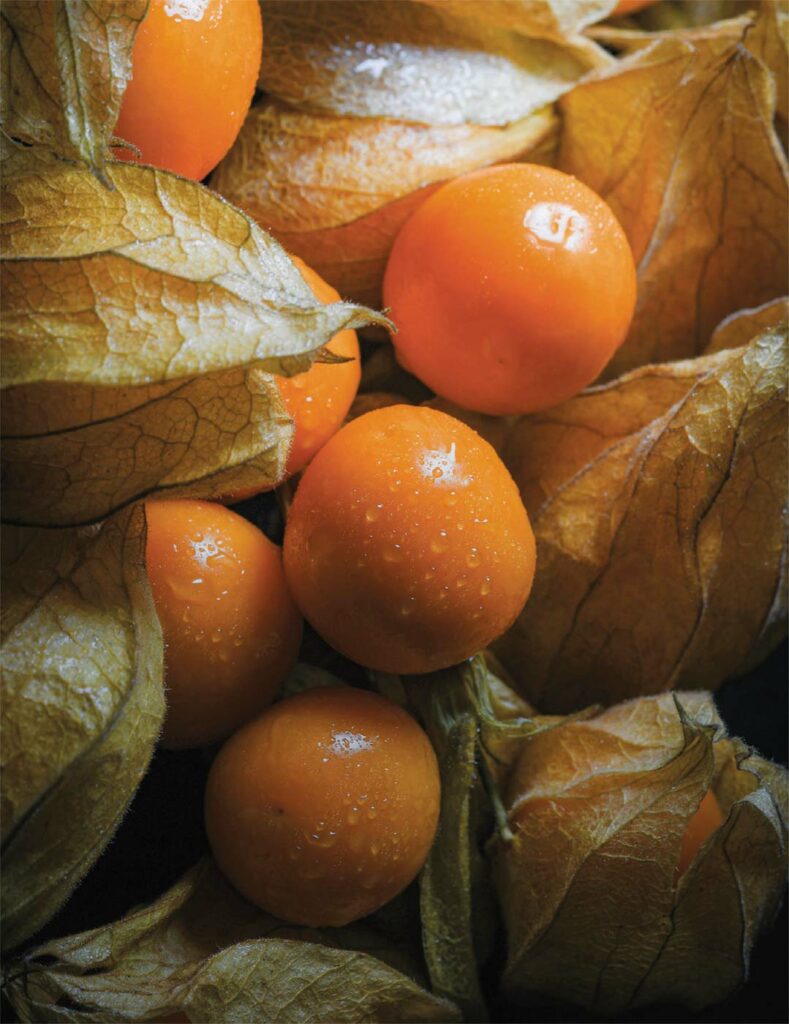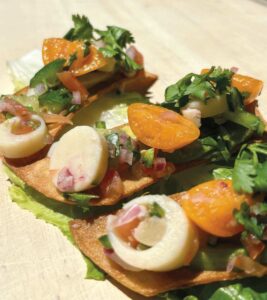
A glitzy way to add a burst of flavor to meats and salads
I didn’t really realize how much I liked golden berries until I had an abundance of them and a Sol Seeker Farm duck to cook for Thanksgiving. Inspired by their orange hue and pineapple-y mango flavor, I reduced them with a little brown sugar and hint of cardamom into a glaze for my duck. The beautiful apricot color glistened on my roast duck while the sweet tart flavor and cardamom imparted exoticness beyond compare as it mingled with the parsnips in the Dutch oven.
Golden berries are actually fruits in the Solanaceae family and related to nightshades, like tomatoes, potatoes, eggplant and, you guessed it—tomatillos.
Both tomatillos and golden berries grow similarly inside their calyx, a protective layer that encases the fruit. They are closely related and resemble smaller versions of tomatillos but with a tangy orange, sweet fruit and an essence of tomato within their papery husk.
Golden berries can be eaten fresh and are great on top of a salad, thrown into smoothies, added to overnight oats with vanilla protein powder, roasted and blended into a sweet salsa with pineapple which is perfect on fish or shrimp tacos, or slow cooked with a pork roast or poultry.
Dried golden berries have a nice zing similar to sour candy and can be added to homemade granola or yogurt, or used to make raw vegan treats by adding them to soaked cashews or almonds, some dates, turmeric powder and rolling them in shredded coconut or hemp seeds.
FRUIT OF MANY NAMES
Native to Peru, golden berries are called Inca berries in their native land. They have been cultivated for hundreds of years in South America and originally were only grown for Inca royalty, partly because they were considered a potent super food. They have been grown in England since the 18th century and later in South Africa, where they are called cape gooseberries, after the Cape of Good Hope. It wasn’t until the 20th century that the fruit of many names was cultivated around the world in tropical and temperate zones.
While they are technically a fruit, they are not a true berry or a cherry! Farmers I know call them a variety of things including Peruvian ground cherries, husk cherries and gooseberries. In Hawaii they are called poha berry, and on fancy dessert menus you may see them called Physalis, its scientific name. My favorite name was given by the French—amour en cage or love in a cage—referring to their pretty calyx over what resembles a tomato, sometimes known as a love apple.
There are two types of golden berries, Physalis peruviana and Physalis pruinosa. Once harvested, it might be hard to tell the difference, however they are different. At Serendipity Farms, we grow the peruviana variety because I was gifted seeds from a farmer friend who brought them back from South America to share. I like this variety because it grows upright and you don’t have to pick the fruit off the ground like the pruinosa variety. The leaves are fuzzy in comparison and the fruit is larger. The drawback to this variety is that it takes much longer to ripen, but since we farm our row crops on the coast, it works well—we don’t receive frosts that would kill them and we can have some interesting fruit on our tables in winter when there isn’t much to offer. They can even be a perennial crop if grown in a hoop house or outdoors where winter temperatures stay above 45 degrees.
Spade & Plow Organics grows the heirloom cultivar goldie, which is a pruinosa variety. This variety is native to Northern Mexico. Farmer Sam Thorp learned about what he calls ground cherries when he was working at a culinary garden for a fine dining restaurant. He says people now know more about them and they are the “specialty of specialty crops.”
Sam, his dad and brother farm in Morgan Hill and Gilroy where it is warmer than on the coast and golden berries are quicker to harvest. Beginning in August, the fruit starts to fall on the ground.
Thorp appreciates how the fruit falls, indicating they are ready to be harvested, because that way they are sure the fruit is at its peak of flavor.
At Spade & Plow, only one long bed of golden berries is grown annually, which is plenty for their farmers markets and wholesale accounts because they are so prolific.
“I like to eat them fresh and keep it simple,” says Thorp. “I don’t like to alter the flavor too much. I sometimes cook them into a compote and add them to ice cream. When customers ask what husk cherries taste like, I tell them the flavor is like nothing else; they have a flavor all their own.”

My favorite name was given by the French— amour en cage or love in a cage.
IN THE GARDEN
It is quite easy to grow these little vitamin C bombs. Many of my farmers market customers comment on how they grow as volunteers in their compost pile and have been re-growing year after year on their own without purposeful management. Just like a tomatillo, golden berry seeds are prolific if left to their own devices. In areas that receive no frost, you can even grow them as a perennial.
If you want to grow them, it is best to start them in seedling trays in a greenhouse or sunny window in the spring. Plant the seeds ¼-inch deep in organic seedling mix, keeping soil moist. When they have a few true leaves, harden them outside for at least a week in their seedling trays so they can acclimate to the outdoor environment. Golden berries take a while to grow big and strong enough to plant in the garden. At my farm, they are the last of the Solanaceae family ready to be planted in the ground. However, they are also the last to keep producing.
Be aware however that only the orange fruit is edible; do not eat unripe, green fruit. The outer husk and plant are toxic to humans and animals, so plant out of reach of pets and children that might eat them. If you are growing the upright variety, it is easier to locate and harvest the fruit if you trellis golden berries using tomato cages or posts and twine. You can also let them go wild. Darryl Gunderson, a rare fruit grower and permaculture enthusiast in Santa Cruz, reports that he grows them in his permaculture food forest. He appreciates their ability to smother weeds and likes that they not only grow in full sun but also grow in shady areas of the garden, under a tree canopy. They make great snacks for foraging chickens, too.
HEALTH BENEFITS
Loaded with antioxidants, golden berries contain over 70% of your daily vitamin A needs, and are high in vitamins B and C, with loads of fiber, potassium and magnesium. Especially good for vegans and vegetarians, this little superfood is high in iron, making it a wonderful snack eaten fresh or dried.
Pick up some golden berries at your local farmers market this summer and have fun incorporating them into your seasonal eating experience. Kids love peeling off the husk to discover a bright orange fruit and they will enjoy helping to process them. Discovering new foods and preparing them with family and friends is what life is all about!

About the author
Jamie Collins is the owner of Serendipity Farms and has been growing organic row crops at the mouth of Carmel Valley since 2001. She distributes her produce through a CSA, u-picks and farmers’ markets.
- Jamie Collinshttps://www.ediblemontereybay.com/author/jcollins/
- Jamie Collinshttps://www.ediblemontereybay.com/author/jcollins/
- Jamie Collinshttps://www.ediblemontereybay.com/author/jcollins/
- Jamie Collinshttps://www.ediblemontereybay.com/author/jcollins/



